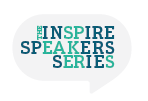Every month, GBA invites a remarkable nationally known speaker to present a public lecture as part of our Inspire Speakers Series. On the following day, the speaker works directly with GBA’s Green & Healthy Schools Academy in a day-long workshop. Since not everyone can always attend these great talks on the second Thursday of each month, we shall attempt to share some of the more pointed remarks, so everyone can learn something new.
Here are a few of my notes from Bob Berkebile’s Inspire Speakers Series lecture on Thursday, March 13, titled Urban Acupuncture: Redefining Community Vitality by Design.
Bob is rich with experience and accomplishments. If you want to learn more about him, look here.
At the start of his talk, Bob called out some of the successful projects here in Pittsburgh, especially the new Eden Hall campus at Chatham University and of course, the Phipps Center for Sustainable Landscapes. He also noted the work still being done by Bill Strickland (a previous Inspire Speakers Series lecturer), and the tenacious research being done by Vivian Loftness and Volker Hartkopf at Carnegie Mellon University.
Bob noted that the term “Urban Acupuncture” – which has become much of the focus of his current thinking – originated with Barcelonan architect and urbanist, Manuel de Sola Morales. He cited the need for a new way of thinking by saying that current educational systems are not working; in fact, many of the systems within which we live and work, are not working. He suggested that our Energy, Water, Transportation and Agricultural systems, on which we all depend , are at least ten years out of synch with the reality of today, and we need to catch them up or we will have many more problems.
When we try to pick out anything by itself, we find it hitched to everything else in the Universe. – John Muir
Bob then suggested that the answer lies in “Systems Thinking.” That is, consider entire systems, not just parts of the system. Key to this is building awareness, which will then lead to an increase in creative thinking and solutions. He noted that he learned much of this approach directly from the venerable Buckminster Fuller.
Bob moved the discussion into the realm of community transformations that are especially feasible after large natural disasters. He gave examples of Greensbug, KS after the tornado and New Orleans after Hurricane Katrina. He mentioned that they took great pains to include EVERYONE in the discussions afterwards, including women, children, old and young to add their ideas regarding what to do next. It was not limited to just the (typically) men who had been running the town. Bob made the point that success from that point forward was based on this larger level of community involvement because they (people other than those in traditional leadership positions) “ask questions that change the outcome.”
There is no greater power than a community discovering what it cares about. – Meg Wheatley
Bob stated that Design can be Instructive or Destructive. People in the Design business need to pay attention. Calling on research done by others, but including Vivian and Volker at CMU, Bob noted that good design has been shown to yield 60% increases in productivity, 9% decreases in absenteeism, and can lead to net zero energy and net zero water buildings.
There are three aspects to developing and executing on a Community Vision, Bob explained:
- Discovery: Understanding what was here before; what’s important now? A community “word cloud” is a great way of representing all this in one image.
- Declaration: State what is possible now. (In one project he did in Kansas City, this translated to “Consider this abandoned school as a centerpiece for the project.”)
- Opportunity: Be ready when the door/window of opportunity presents itself. (The school was available, but it did not just become 50 apartments, it also became a community center and a computer lab and a greenhouse and a medical center and more. And 14 workers got on-site job training during construction that led to job opportunities AFTER this project.)
Bob noted that Commerce Bank in Kansas City played a key role in financing this project. It has had great financial success, and he has the cachet to do another urban acupuncture project like this again (he IS doing another project in KC now), but we still need more data, more successes in the market, to develop comfort level among financiers.
Bob ended by noting that he and his wife had recently traveled to Bhutan, specifically to understand more about how they (and Denmark) are consistently ranked “the happiest countries in the world.” Without noting too many specifics, he suggested that much originates in the Buddhist culture and their generous spirit.
Bob did not use this, but his talk reminded me of a quote from Buddha that reflects back well on Bob Berkebile and his life of service:
“A generous heart, kind speech, and a life of service and compassion are the things which renew humanity.”
Hope to see you at the next Inspire Speakers Series on Thursday April 10 when Dr. John Francis joins us.
